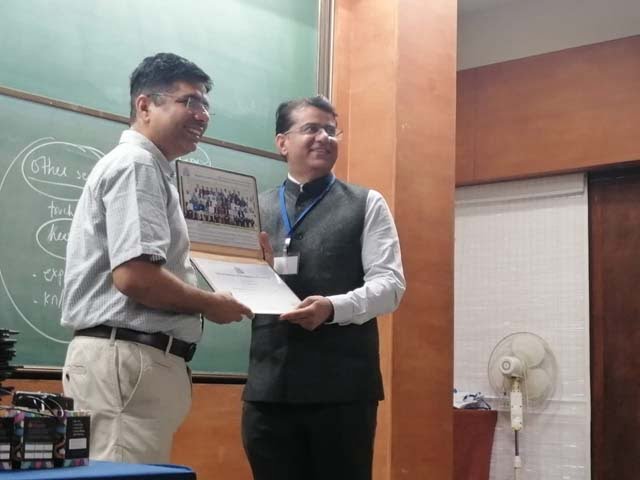कनकधारा स्तोत्र, धन प्राप्ति का चमत्कारी उपाय
Reading Time: 5 minutes Spread the love कनकधारा स्तोत्र, धन प्राप्ति का चमत्कारी उपाय धन की तलाश में हम सभी अपने जीवन में एक समय…
Dr AvinashTank, is a super-specialist (MCh) Laparoscopic Gastro-intestinal Surgeon,
Cirrhosis is a condition in which the liver slowly deteriorates and is unable to function normally due to chronic, or long lasting, injury. Scar tissue replaces healthy liver tissue and partially blocks the flow of blood through the liver.
The liver is the body’s largest internal organ. The liver is called the body’s metabolic factory because of the important role it plays in metabolism—the way cells change food into energy after food is digested and absorbed into the blood.
A healthy liver is necessary for survival. The liver can regenerate most of its own cells when they become damaged. However, if injury to the liver is too severe or long lasting, regeneration is incomplete, and the liver creates scar tissue. Scarring of the liver, also called fibrosis, may lead to cirrhosis.
Many people with cirrhosis have no symptoms in the early stages of the disease. However, as the disease progresses, a person may experience the following symptoms: fatigue, or feeling tired, weakness, itching, loss of appetite, weight loss, nausea, bloating of the abdomen from ascites, swelling in the feet, ankles & jaundice.
Your doctor usually diagnoses cirrhosis based on the presence of conditions that increase its likelihood, such as heavy alcohol use or obesity, and symptoms. Your doctor may test for cirrhosis based on the presence of these conditions alone because many people do not have symptoms in the early stages of the disease. A health care provider may confirm the diagnosis with a medical and family history, physical exam, blood test, imaging tests & liver biopsy.
Blood test: Blood tests & liver function test are done to know the cause of cirrhosis, platelets count & to measure the severity of cirrhosis:
Ultrasound or CECT: These scans are commonly used to show signs of advanced cirrhosis, such as irregularities in the liver surface, gastric varices, and splenomegaly. These tests can also detect signs of complications, such as ascites and liver cancer.
Elastography: Elastography is also called liver stiffness measurement, uses either ultrasound or MRI to measure the stiffness of the liver. Scar tissue increases the stiffness of the liver. Elastography can show how much scarring is present with some reliability.
Liver Biopsy: A liver biopsy can confirm the diagnosis of cirrhosis; however, a person does not always need this test. A biopsy is done if the result might help determine the cause or affect treatment.
As the liver fails, complications may develop. In some people, complications may be the first signs of the disease. Complications of cirrhosis may include the following:
Treatment for cirrhosis depends on the cause of the disease and whether complications are present. In the early stages of cirrhosis, the goals of treatment are to slow the progression of tissue scarring in the liver and prevent complications. As cirrhosis progresses, a person may need additional treatments and hospitalization to manage complications. Treatment may include the following:
Avoiding Alcohol
Avoid unknown medicines (herbs etc)
Viral Hepatitis A & B Vaccination and Screening of Viral hepatitis C
Treating Causes of Cirrhosis: Your doctor can treat some causes of cirrhosis, for example, by prescribing antiviral medications for hepatitis B and C, corticosteroids and other medications for auto-immune hepatitis, bile flow drugs (ursadiol) to relieve jaundice etc.
Treating Symptoms and Complications of Cirrhosis
Varices & Portal hypertension: Beta-blockers can lower the pressure in varices and reduce the likelihood of bleeding. Bleeding in the stomach or esophagus requires an immediate upper endoscopy. This procedure involves using an endoscope—a small, flexible tube with a light—to look for varices & band ligation is one, a procedure that involves placing a special rubber band around the varices that causes the tissue to die and fall off.
Ascites Your doctor providers prescribe diuretics—medications that remove fluid from the body—to treat edema and ascites. Your doctor may remove large amounts of ascitic fluid from the abdomen and check for infection (spontaneous bacterial peritonitis).
Hepatic Encephalopathy A health care provider treats hepatic encephalopathy by cleansing the bowel with lactulose, a laxative given orally or as an enema—a liquid put into the rectum. A health care provider may also add antibiotics to the treatment.
Hepatorenal syndrome Some people with cirrhosis who develop hepatorenal syndrome must undergo regular dialysis treatment, which filters wastes and extra fluid from the body by means other than the kidneys. People may also need medications to improve blood flow through the kidneys.
Liver Cancer A health care provider may recommend screening tests every 6 to 12 months to check for signs of liver cancer. Screening tests can find cancer before the person has symptoms of the disease. Cancer treatment is usually more effective when its diagnosed early. Health care providers use blood tests, ultrasound, or both to screen for liver cancer in people with cirrhosis. He or she may treat cancer with a combination of surgery, radiation, and chemotherapy.
Its time for transplant: Your doctor may advice a liver transplant when cirrhosis leads to liver failure or treatment for complications is ineffective. Liver transplantation is surgery to remove a diseased or an injured liver and replace it with a healthy whole liver or part of a liver from another person, called a donor.
Compensated Cirrhosis: If Cirrhosis is don’t cause any complications like jaundice, bleeding, ascites or encephalopathy, is medically labelled as “Compensated cirrhosis”. Cirrhosis can remain compensated for many years. The transition from compensated to decompensated cirrhosis ( ie. Cirrhosis with any of complications) occurs at a rate of approximately 5 to 7% per year. The median survival of compensated cirrhotics has been reported to be 9 to 12 years.
Decompensated cirrhosis means person with cirrhosis has jaundice, ascites, variceal hemorrhage, or hepatic encephalopathy. In general, survival is poor in patients with decompensated cirrhosis and they should be considered for liver transplantation. Patients with ascites and variceal hemorrhage have a reported 1-year survival rate of less than 50%.
A healthy diet is important in all stages of cirrhosis because malnutrition is common in people with this disease. If ascites develops, take sodium-restricted diet. A person with cirrhosis should not eat raw shellfish, which can contain a bacterium that causes serious infection.
There are risks that go with any type of medical procedure and surgery is no longer an exception. Success of surgery depends upon 3 factors: type of disease/surgery, experience of surgeon and overall health of patients. What's important is whether the expected benefits outweigh the possible risks.
Doctors have been performing surgeries for a very long time. Advances in surgical techniques and our understanding of how to prevent infections have made modern surgery safer and less likely to damage healthy tissues than it has ever been. Still, there’s always a degree of risk involved, no matter how small. Different procedures have different kinds of risks and side effects. Be sure to discuss the details of your case with our health care team, who can give you a better idea about what your actual risks are. During surgery, possible complications during surgery may be caused by the surgery itself, the drugs used (anesthesia), or an underlying disease. Generally speaking, the more complex the surgery is the greater the risk. Complications in major surgical procedures include:

Experience
Award & Presentations
Satisfied Families
Successful Surgeries

Endoscopy
Reading Time: 5 minutes Spread the love कनकधारा स्तोत्र, धन प्राप्ति का चमत्कारी उपाय धन की तलाश में हम सभी अपने जीवन में एक समय…
Reading Time: 2 minutes Spread the love Mucus Discharge from Rectum After Stoma Surgery: Normal or Concerning? If you’ve had ostomy surgery, either a loop ileostomy…
Reading Time: 2 minutes Spread the love National Doctors Day 2024: Celebrating Our Medical Heroes on 1st July. Every year on 1st July, we come together…
Lorem Ipsum is simply dummy text of the printing and typesetting industry. Lorem Ipsum has been the industry's standard dummy text ever since the 1500s, when an unknown printer took a galley of type and scrambled it to make a type specimen book. It has survived not only five centuries, but also the leap into electronic typesetting, remaining essentially unchanged.
